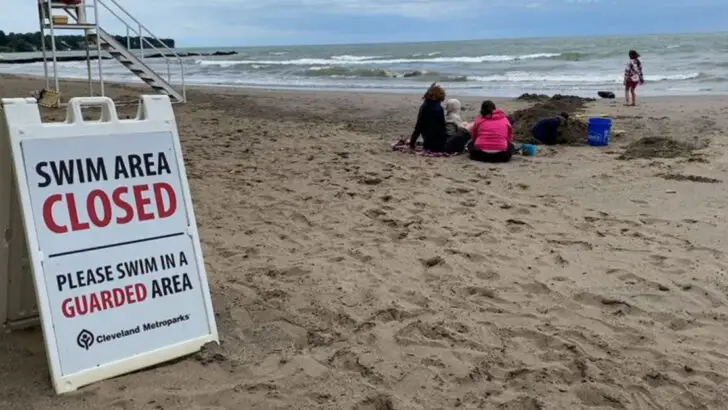Some lakes look like paradise—until you step in. Beneath the glassy surfaces of these 13 U.S. lakes lurk dangers most swimmers never see coming. We’re talking bacteria spikes, toxic algae blooms, and hidden drop-offs that have turned summer getaways into cautionary tales. Each year, these waters make headlines for all the wrong reasons. From Florida to the Pacific Northwest, families show up with floaties and sunscreen… unaware of the warnings quietly posted nearby. This isn’t about scare tactics—it’s about swimming smart. If your summer plans include a lake day, keep reading. These are the ones experts say come with risks too serious to ignore.
Lake Michigan, Illinois
Lake Michigan’s serene beauty hides fierce rip currents, especially near Chicago’s beaches. These currents can pull even strong swimmers into deep waters. Authorities frequently issue warnings during high-risk conditions. Surprisingly, it’s not just the waves but sudden drop-offs that pose threats. Swimmers often find themselves in deeper water unexpectedly. Additionally, pollution from industrial activities has raised concerns about water quality. While locals cherish its sunsets, visitors must heed warnings.
Lake Lanier, Georgia
Lake Lanier, a popular spot in Georgia, harbors unexpected dangers beneath its surface. Submerged structures like trees and man-made debris create hazards for swimmers. Despite its allure as a recreational hub, currents can be unpredictable, making swimming risky. Many locals share tales of narrow escapes, reminding visitors to stay vigilant. Moreover, variations in water levels can expose or hide these dangers without warning. It’s a lake of beauty and caution.
Lake Erie, Ohio
Lake Erie, known for its vastness, often experiences sudden weather changes, leading to choppy waters. These conditions can catch swimmers off guard, making it perilous. The lake’s shallow depth contributes to swift wave formations. Historical accounts recall shipwrecks, a testament to its unpredictability. Water quality issues further exacerbate risks, with pollutants affecting health. While a popular destination, one must respect its waters’ capricious nature. Erie is as much a guardian as a challenger.
Lake Pontchartrain, Louisiana
Lake Pontchartrain’s vast expanse can be deceiving. While appearing calm, it’s notorious for its sudden storms. These can rapidly transform tranquil waters into turbulent ones. The lake’s proximity to industrial areas raises water quality concerns. Stories of sudden squalls are common, emphasizing the need for caution. It’s a location where nature’s power is profoundly evident, demanding respect from those who venture in. A haven of contrasts, it captivates and challenges alike.
Lake Tahoe, California/Nevada
Lake Tahoe, a jewel of the Sierra Nevada, has its own set of challenges. Cold temperatures, even in summer, pose hypothermia risks. The lake’s depth and clarity can deceive swimmers about distances. Tales of explorers underestimating its chill are frequent. Despite its allure, swimmers must be aware of the abrupt temperature drops. The beauty of Tahoe’s blue invites, but awareness of its icy embrace is crucial for safety. A gem with a cold heart.
Lake Mead, Nevada
Lake Mead, serving as a reservoir, faces fluctuating water levels that expose submerged hazards. Its vastness can be misleading, with sudden wind changes creating dangerous wave conditions. Historical artifacts beneath its waters attract but can also trap. Stories of lost treasures intrigue, yet caution is paramount. It’s a place where history and present-day risks intertwine, making awareness essential for those who venture. A reservoir of intrigue and caution.
Lake Havasu, Arizona
Lake Havasu, known for vibrant boating culture, poses risks for swimmers due to heavy traffic. The mix of boats and swimmers is a recipe for potential accidents. Despite its party atmosphere, awareness and caution are vital. Many recount close calls, highlighting the need for vigilance. It’s a dynamic environment where relaxation meets responsibility. Swimmers must navigate not only waters but also bustling activities. A lively spot demanding alertness.
Lake Okeechobee, Florida
Lake Okeechobee, Florida’s largest freshwater lake, presents unique challenges. Its shallow depth can generate strong winds, causing rough waters. The lake’s proximity to marshlands means encounters with wildlife are possible. Alligators and snakes are not uncommon sights, demanding respect from visitors. Despite its beauty, the lake’s natural inhabitants remind swimmers of their presence. Okeechobee is a wild frontier where nature commands respect. A blend of beauty and caution.
Lake of the Ozarks, Missouri
Lake of the Ozarks, a Midwest paradise, is not without its dangers. Busy boat traffic poses significant risks for swimmers. Accidents are not rare, with stories of close calls shared among locals. The lake’s winding shape can create unexpected currents, challenging even experienced swimmers. Despite its beauty, the need for vigilance is ever-present. A destination where leisure and alertness go hand in hand. The Ozarks’ allure is matched by its demands for awareness.
Lake Washington, Washington
Lake Washington, bordered by bustling Seattle, is a popular recreational spot. However, urban runoff contributes to pollution, affecting water quality. Swimmers must be mindful of potential health risks. The lake’s expanse can also create unexpected currents, challenging even seasoned swimmers. Local anecdotes warn of sudden weather changes. It’s a lake where urban meets nature, offering beauty but demanding respect for its waters. A city gem with hidden challenges.
Lake Powell, Utah/Arizona
Lake Powell, a stunning reservoir, presents hidden challenges. Its intricate canyons can confuse swimmers, leading to potential disorientation. Stories of explorers losing their way are common. The lake’s beauty attracts, but its maze-like structure requires awareness. Sudden wind shifts can create dangerous conditions, adding to its risks. This picturesque location demands respect and preparation from its visitors. A natural wonder with a labyrinthine challenge.
Lake Winnebago, Wisconsin
Lake Winnebago, known for its winter ice fishing, poses seasonal risks. As ice forms, it can be perilous for unprepared visitors. Stories of ice breakthroughs are shared with cautionary tones. Even in warmer months, the lake’s open expanse can create challenging winds. It’s a place where weather plays a crucial role in safety. Winnebago combines recreation with a need for constant vigilance. A seasonal gem with shifting challenges.
Lake Champlain, Vermont/New York
Lake Champlain, nestled between the Adirondacks and Green Mountains, is not immune to danger. Sudden storms can transform its tranquil surface, catching boaters and swimmers off guard. The lake’s history of naval battles adds a layer of intrigue, but awareness of its capricious nature is crucial. Despite its scenic beauty, Champlain demands vigilance from those who explore its waters. A historical lake with modern-day challenges.

